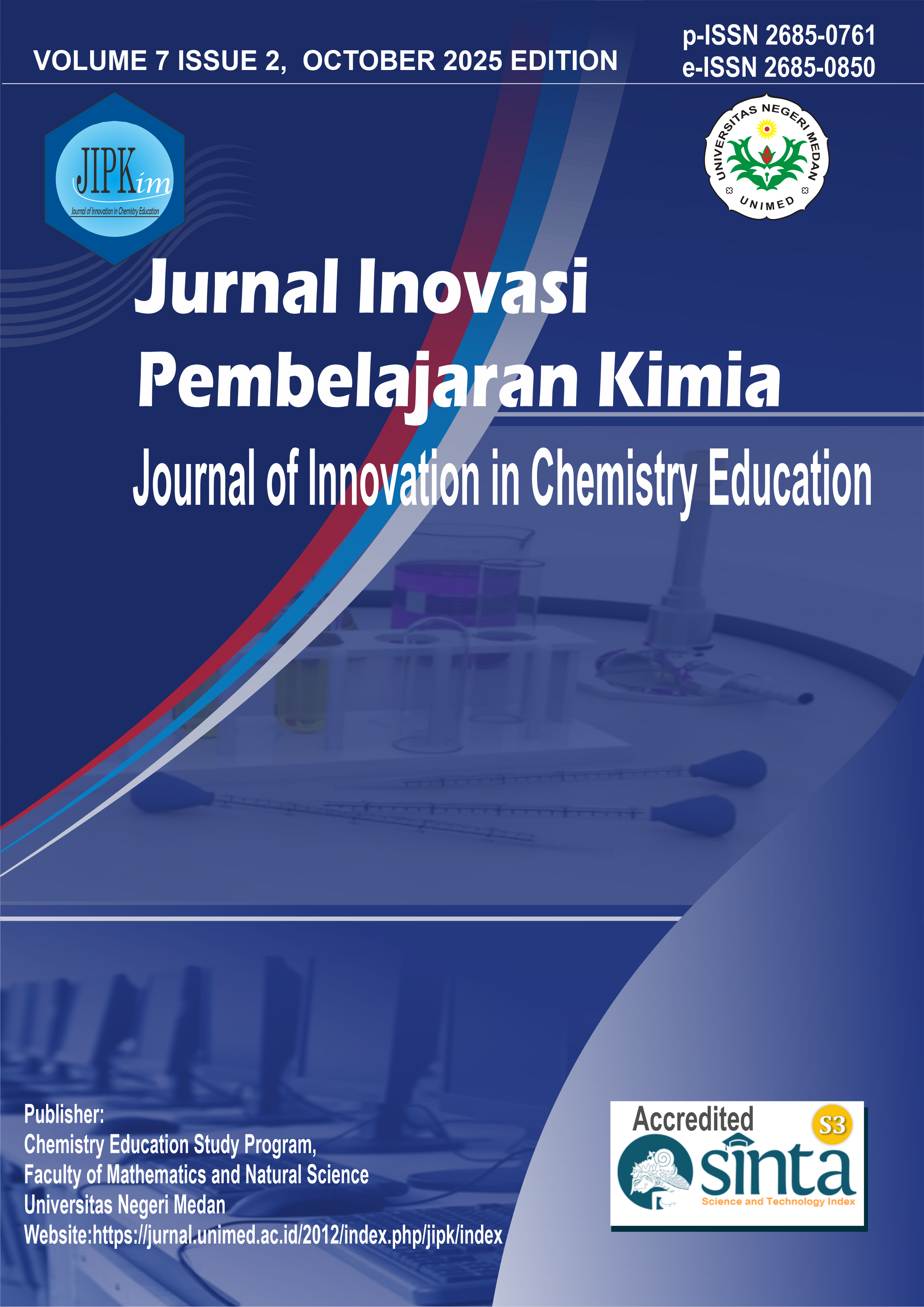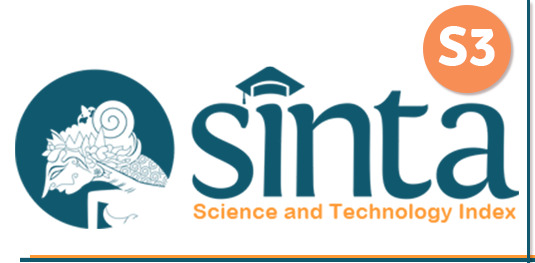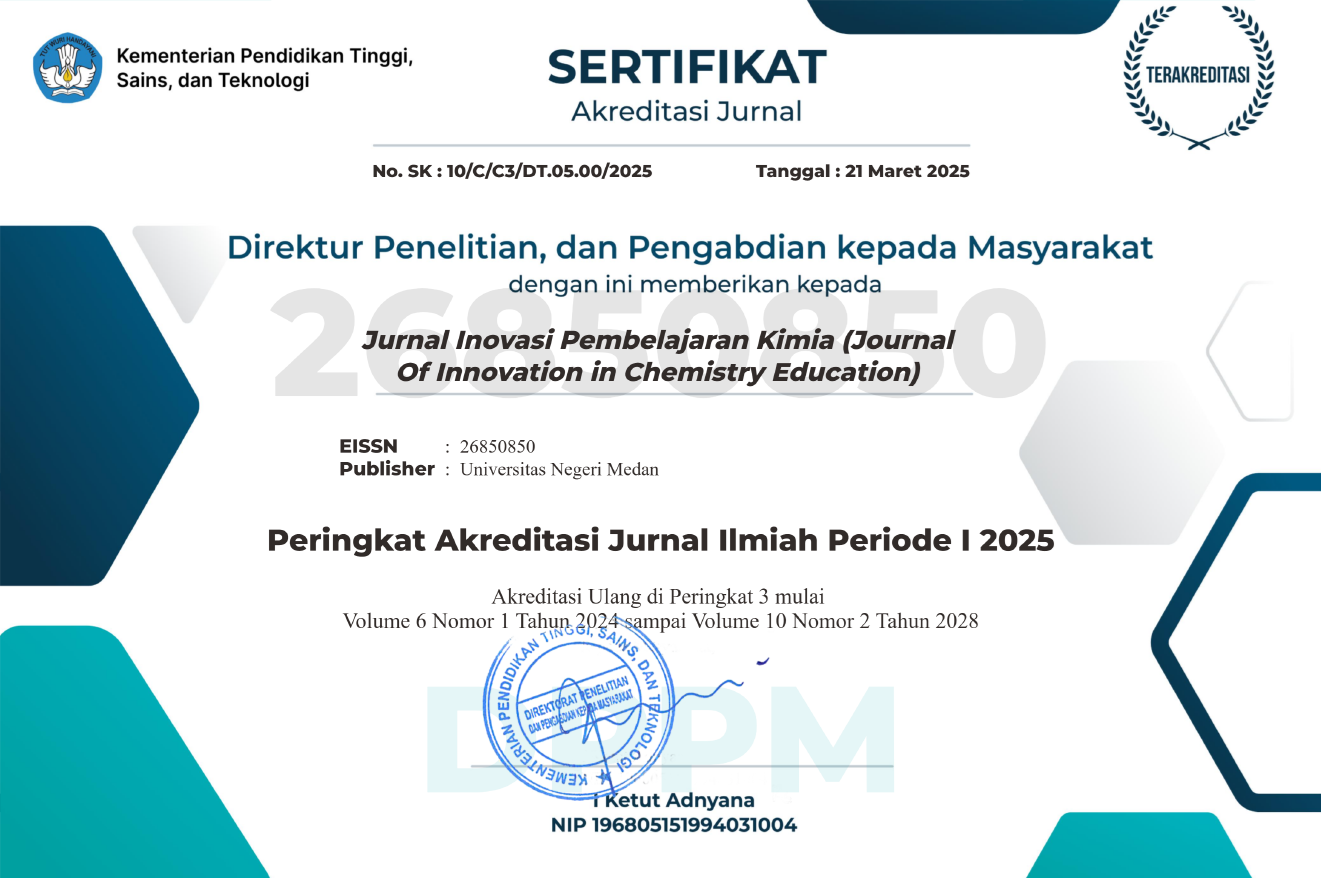Development of Intertextual-Based Learning Videos on Corrosion Concept
Keywords:
Intertextual-based learning, Corrosion, Chemical representations, Instructional Video, Chemistry educationAbstract
This study aimed to develop and evaluate an intertextual-based instructional video on the topic of corrosion by integrating macroscopic, submicroscopic, and symbolic representations within a constructivist multimedia framework. The development followed the ADDIE model through five stages: analysis, design, development, implementation, and evaluation. The video, divided into three segments—corrosion process, prevention methods, and influencing factors—was validated by experts in content, pedagogy, and media. Validation results showed high feasibility with scores of 84.2% (content), 93.75% (pedagogy), and 88.86% (media), all categorized as “Very Good.” Teacher responses averaged 97.29%, while student responses reached 100%, indicating excellent clarity, contextual relevance, and engagement. Minor revisions related to narration and animation sequencing were implemented based on expert feedback. The main innovation of this study lies in combining intertextual contexts with multilevel chemical representations to make abstract electrochemical processes more accessible. The developed video is feasible for use as a teaching aid in electrochemistry and has potential for adaptation to other chemistry topics requiring multiple representations.References
A'qidah, I., & Rahmawan, S. (2024). Intertextual-Based Chemistry Learning in Salt Hydrolysis Concept to Improve Students' Science Process Skills. Didaktika: Jurnal Kependidikan, 13(4 Nopember), 5195-5208. https://doi.org/10.58230/27454312.1152
Adjei, Y., Duku, P., Donkor, J., & Boachie, S. (2024). YouTube Video Technology in Chemistry Classroom: Its Impact on Pre-Service Teachers’ Attitude and Academic Performance. European Journal of Mathematics and Science Education, 5(1), 39-50. https://doi.org/10.12973/EJMSE.5.1.39
Alhashem, F., & Alfailakawi, A. (2023). Technology-Enhanced Learning Through Virtual Laboratories In Chemistry Education. Contemporary Educational Technology, 15(4), ep474. https://doi.org/10.30935/cedtech/13739
Bohloko, M., Makatjane, T. J., George, M. J., & Mokuku, T. (2019). Assessing The Effectiveness Of Using Youtube Videos In Teaching The Chemistry Of Group I And VII Elements In A High School In Lesotho. African Journal of Research in Mathematics, Science and Technology Education, 23(1), 75–85. https://doi.org/10.1080/18117295.2019.1593610
Branch, R. M. (2010). Instructional Design: The ADDIE Approach. Instructional Design: The ADDIE Approach. Springer US. https://doi.org/10.1007/978-0-387-09506-6
Dewi, N. S., & Mulyani, S. (2024). Enhancing Conceptual Understanding of Buffer Solutions with an Intertextual E-Book Prototype. JKPK (Jurnal Kimia dan Pendidikan Kimia), 9(2), 311-323. https://doi.org/10.20961/jkpk.v9i2.85269
Fadli, A., Panggabean, F. T. M., & Aruan, N. (2025). Motivation And Learning Outcomes In Acid-Base Topics Using Video-Assisted PBL And Discovery Learning. Jurnal Inovasi Pembelajaran Kimia (Journal of Innovation in Chemistry Education), 5(3), 162–168. https://doi.org/10.24114/jipk.v7i1.67947
Fayomi, O. S. I., Akande, I. G., & Odigie, S. (2019). Economic Impact of Corrosion in Oil Sectors and Prevention: An Overview. Journal of Physics: Conference Series, 1378(2). https://doi.org/10.1088/1742-6596/1378/2/022037
Getu, G. tsadik, Mebrahitu, G. kidan, & Yohannes, G. (2024). Effects of Context-Based Teaching Chemistry on Students’ Achievement: A Systematic Review. Jurnal Pijar Mipa, 19(2), 190–197. https://doi.org/10.29303/jpm.v19i2.6458
Hamerská, L., Matěcha, T., Tóthová, M., & Rusek, M. (2024). Between Symbols And Particles: Investigating The Complexity of Learning Chemical Equations. Education Sciences, 14(6), 570. https://doi.org/10.3390/educsci14060570
Hatimah, H., & Khery, Y. (2021). Mataram Pemahaman Konsep dan Literasi Sains dalam Penerapan Media Pembelajaran Kimia Berbasis Android. Jurnal Ilmiah IKIP Mataram, 8(1). https://ojs.ikipmataram.ac.id/index.php/jiim
Herrington, D. G., & Sweeder, R. D. (2025). Is this a helpful YouTube video? A Research-Based Framework For Evaluating And Developing Conceptual Chemistry Instructional Videos. Journal of chemical education, 102(2), 621-629. https://doi.org/10.1021/acs.jchemed.4c01085
Kahsay, T. T., Berhe, G. G., & Tesfamariam, G. M. (2024). The Extent Of Audio-Visual Material Use In The Teaching And Learning Of Chemistry In Secondary Schools. African Journal of Chemical Education, 14(2), 128-159. ISSN 2227-5835. Retrieved from https://faschem.co.za/wp-content/uploads/2024/06/AJCE_2024_May_Special.pdf#page=131
Lalian, O. N. (2018). The Effects of Using Video Media in Mathematics Learning On Students’ Cognitive And Affective Aspects. AIP Conference Proceedings, 2019. https://doi.org/10.1063/1.5061864
Mahbub, S., Wafik, H. A., Uddin, A., & Rahman, M. (2024). Integration Of Technology In Chemistry Education At University Level. Cognizance Journal of Multidisciplinary Studies, 4(7), 9-19. https://doi.org/10.47760/cognizance.2024.v04i07.002
Mayer, R. E. (2021). Research-Based Principles for Designing Multimedia Instruction. in In Their Own Words: What Scholars and Teachers Want You To Know About Why and How To Apply The Science of Learning In Your Academic Setting (pp. 143–157). Society for the Teaching of Psychology. https://teachpsych.org/ebooks/itow
Nabila, P. W., Widhiyanti, T., & Mulyani, S. (2024). Review of Chemistry Learning Modules on the Impact of Students' Literacy. KnE Social Sciences, 188-199. https://doi.org/10.18502/kss.v9i8.15506
Naimah, A. (2022). The Use Of Video As A Learning Media In Science Learning (A Systematic Review). AL-ISHLAH: Jurnal Pendidikan, 14(4), 6941-6950. https://doi.org/10.35445/alishlah.v14i4.1565
Nisa, N. A., & Fitriza, Z. (2021). Identifikasi Mikonsepsi Siswa Menengah Atas (SMA) Pada Pembelajaran Kimia Materi Redoks dan Elektrokimia : Studi Literatur. EDUKATIF : JURNAL ILMU PENDIDIKAN, 3(4), 1191–1198. https://doi.org/10.31004/edukatif.v3i4.516
Nugrohadi, S., & Chasanah, I. (2022). Identifikasi Miskonsepsi Siswa Kelas X pada Pembelajaran Reaksi Redoks di Kurikulum Merdeka. Jurnal Pendidikan MIPA, 12(4), 1085–1093. https://doi.org/10.37630/jpm.v12i4.746
Pekdaǧ, B. (2020). Video-Based Instruction on Safety Rules in The Chemistry Laboratory: Its Effect on Student Achievement. Chemistry Education Research and Practice, 21(3), 953–968. https://doi.org/10.1039/d0rp00088d
Puspitarini, Y. D., & Hanif, M. (2019). Using Learning Media to Increase Learning Motivation in Elementary School. Anatolian Journal of Education, 4(2), 53–60. https://doi.org/10.29333/aje.2019.426a
Qian, Y., Wang, Y., Wen, J., Wu, S., & Zhang, J. (2023). One Hundred Core Concepts in Chemistry and Upper-Secondary School Teachers’ and Students’ Chemistry Conceptual Structures. Journal of Baltic Science Education, 22(3), 493–505. https://doi.org/10.33225/jbse/23.22.493
Rahayu, D. S., Yanti, M., & Lestari, A. (2023). Students’ Chemistry Multiple Representation Ability in Voltaic Cell Materials. Journal of Tropical Chemistry Research and Education, 5(1), 44–53. https://doi.org/10.14421/jtcre.2023.51-06
Ramachandran, R., Sparck, E. M., & Levis-Fitzgerald, M. (2019). Investigating the Effectiveness of Using Application-Based Science Education Videos in a General Chemistry Lecture Course. Journal of Chemical Education, 96(3), 479–485. https://doi.org/10.1021/acs.jchemed.8b00777
Riduwan. (2010). Metode dan Teknik Menyusun Tesis (8th ed.). Alfabeta.
Rizal, Wiji, Widhiyanti, T., & Islahiah, N. (2024). Multi-representation Analysis of General Chemistry Books on Chemical Bonding Subject. Orbital: Jurnal Pendidikan Kimia, 8(1), 61-70. https://doi.org/10.19109/ojpk.v8i1.21609
Ryu, M., Nardo, J. E., & Wu, M. Y. M. (2018). An Examination Of Preservice Elementary Teachers’ Representations About Chemistry In An Intertextuality-And Modeling-Based Course. Chemistry Education Research and Practice, 19(3), 681-693. https://doi.org/https://doi.org/10.1039/C7RP00150A
Sarina, Auliah, A., & Hardin. (2024). Development Of Animation Video Learning Media To Improve Class XI Science Students’ Understanding. Jurnal Inovasi Pembelajaran Kimia (Journal of Innovation in Chemistry Education), 4(4), 245–253.
Sasan, J. M. V., & Rabillas, A. (2022). Multimedia English Teaching Approach Based On Constructivist Learning Theory. ELTALL: English Language Teaching, Applied Linguistic and Literature, 3(2), 51-65. https://doi.org/10.21154/eltall.v3i2.4607
Sembiring, D., & Susanti N. (2023). Development of Powtoon-Based Audio-Visual Media in Chemical Bonding Materials. Jurnal Inovasi Pembelajaran Kimia (Journal of Innovation in Chemistry Education), 5(2), 94-101. https://doi.org/10.24114/jipk.v5i2.45014
Silitonga, Y. S., & Muchtar, Z. (2023). Development Of Learning Media Integrated With Problem-Based Learning Model Using Android-Based Application. Jurnal Inovasi Pembelajaran Kimia (Journal of Innovation in Chemistry Education), 3(2), 83–93. https://doi.org/10.24114/jipk.v5i1.45009
Sugiyono. (2017). Metode Penelitian Kualitatif (Untuk penelitian yang bersifat: eksploratif, enterpretif, interaktif dan konstruktif) (S. Y. Suryandari, Ed.; 1st ed.). Alfabeta.
Sumanik, N. B., Arismunandar, A., Nurhikmah, N., & Indrawati, N. (2024). Green Chemistry Learning Transformation: Youtube Integrated Interactive Video to Improve Critical Thinking Skills. Indonesian Journal of Educational Development (IJED), 5(3), 346-357. https://doi.org/10.59672/ijed.v5i3.4218
Suryati, S., Adnyana, P. B., Ariawan, I. P., & Wesnawa, I. G. A. (2024). Integrating Constructivist and Inquiry Based Learning in Chemistry Education: A Systematic Review. Hydrogen: Jurnal Kependidikan Kimia, 12(5), 1166-1188. https://doi.org/10.33394/hjkk.v12i5.13571
Tal, M., Herscovitz, O., & Dori, Y. J. (2021). Assessing Teachers’ Knowledge: Incorporating Context-Based Learning In Chemistry. Chemistry Education Research and Practice, 22(4), 1003-1019. https://doi.org/10.1039/D0RP00359J
Tambunan, S. M., Purba, J., & Panggabean, F. T. M. (2024). The Influence Of Problem-Based Learning And Media to Increase Student Interest And Learning Outcomes. Jurnal Inovasi Pembelajaran Kimia (Journal of Innovation in Chemistry Education), 4(2), 120–129. https://doi.org/10.24114/jipk.v6i1.57337
Trianisa, A., & Wahyuni, T. P. (2024). Effectiveness Of Using Youtube Video-Based Science Learning Media On Class VIII Student Learning Outcomes. Science Get Journal, 1(1), 27-33. https://doi.org/10.69855/science.v1i1.26
Uleng, A. T., Damsi, M., & Sembiring, Y. K. (2024). Mental Models in Chemistry Concept: A Systematic Review. Jurnal Penelitian Pendidikan IPA, 10(11), 764-777. https://doi.org/10.29303/jppipa.v10i11.6353
Wildaiman, M., Rosinda Tinenti, Y., & Grizca Boelan, E. (2022). Pengaruh Penggunaan Video Pembelajaran Terhadap Hasil Belajar Siswa Kelas XI IPA SMA PGRI Kupang. EDUSAINTEK: Jurnal Pendidikan, Sains Dan Teknologi, 9(3), 812–820. https://doi.org/10.47668/edusaintek.v9i3.569













